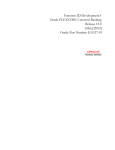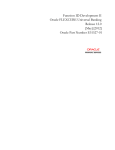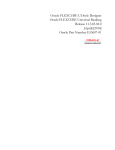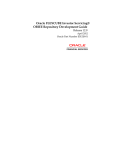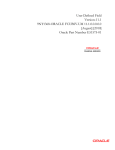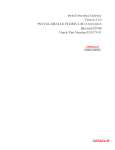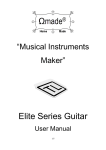Download Extensibility Getting Started
Transcript
Oracle FLEXCUBE Universal Banking® 11.3
Extensibility Getting started
Release 1.0
May 2011
Oracle Part Number E51511-01
Contents
1
Preface.................................................................................................................................................................3
Audience .........................................................................................................................................................3
Related documents ..........................................................................................................................................3
Conventions.....................................................................................................................................................4
Introduction .......................................................................................................................................................4
2.1 How to use this Guide .....................................................................................................................................4
Extensibility Introduction ................................................................................................................................5
3.1 What is extensibility........................................................................................................................................5
3.2 Industry Pattern ...............................................................................................................................................5
3.3 Industry Approach...........................................................................................................................................5
FLEXCUBE UBS Extensibility .........................................................................................................................5
4.1 Business Areas ................................................................................................................................................5
4.2 FLEXCUBE UBS Extensibility approach.......................................................................................................6
4.3 FLEXCUBE UBS Extensibility user roles......................................................................................................6
FLEXCUBE UBS Extensible features ..............................................................................................................8
5.1 Screen changes ................................................................................................................................................8
5.1.1
New Screens ..........................................................................................................................................8
5.1.2
Screen Modifications .............................................................................................................................8
5.1.3
Amend field level attributes...................................................................................................................9
5.1.4
Style Sheet changes................................................................................................................................9
5.1.5
Language conversion of screens.............................................................................................................9
5.2 Functional........................................................................................................................................................9
5.2.1
User Defined fields at Maintenance ......................................................................................................9
5.2.2
New SDE and rule for IC calculation..................................................................................................10
5.2.3
Configurable workflow of Branch Screens ...........................................................................................10
5.3 Processing logic.............................................................................................................................................10
5.3.1
Additional validation logic for a field or group of fields ......................................................................10
5.3.2
Modify defaulting logic for fields.........................................................................................................11
5.3.3
Online contract extensibility ...............................................................................................................12
5.3.4
Batch extensibility ...............................................................................................................................12
5.4 Notifications ..................................................................................................................................................12
5.4.1
Event based notifications .....................................................................................................................12
5.5 Reports ..........................................................................................................................................................13
5.5.1
New BIP Reports .................................................................................................................................13
5.5.2
New OBIEE based reports ...................................................................................................................13
5.6 User defined Advice tags ..............................................................................................................................13
5.6.1
New tag in Advice message .................................................................................................................13
5.7 Interface.........................................................................................................................................................13
5.7.1
Switch Interface ISO8583 configuration.............................................................................................13
5.7.2
Configurable Generic Interface for upload/handoff..............................................................................13
5.7.3
Upload adapter framework...................................................................................................................14
Extensibility development life cycle .............................................................................................................14
6.1 Define Extensibility Requirement .................................................................................................................14
6.2 Identify the Business area of extensibility.....................................................................................................15
6.3 Identify the tools/framework to be used ........................................................................................................15
6.4 Identify the file types & layers applicable.....................................................................................................16
6.5 Develop changes ...........................................................................................................................................16
6.6 Test it in FLEXCUBE environment ..............................................................................................................16
Resources..........................................................................................................................................................16
1.1
1.2
1.3
2
3
4
5
6
7
FD03-01-01 Extensibility Getting Started
2
1 Preface
This document describes the concepts and helps reader to get started using Extensible
framework of FLEXCUBE UBS Application, to develop additional functionalities.
1.1 Audience
The Extensibility getting started book is intended for FLEXCUBE Application
Developers/Users who are authorized to perform the following tasks:
Modify the layouts of existing FLEXCUBE Screens
Modify the existing functionality by adding new fields/tabs/data blocks
Extend the existing screen to have fields based on customer specific table/fields
Add customer specific validations at extension hooks
Add customer specific processing logics in batch processing
Add customer specific notifications
Add customer specific calculation elements
Add customer specific reports
To Use this manual, you need conceptual and working knowledge of the below:
Proficiency
FLEXCUBE UBS Development
overview
Resources
FCUBS-FD01-01-01-Development
Overview Guide
RAD function ID development getting
started
FCUBS-FD02-01-01-RAD Getting
Started
1.2 Related documents
For more information on RAD development and extensibility, refer the below documents:
FCUBS-FD01-01-01-Development Overview Guide
FCUBS-FD02-02-01-RAD Function ID Development
FCUBS-FD02-03-01-RAD Web Service Development
FCUBS-FD02-04-01-RAD BIP Report Integration
FCUBS-FD02-05-01-RAD Notification Development
FCUBS-FD05-02-01-RAD-Reference
FCUBS-FD03-02-01-Extensibility Reference Guide
FCUBS-FD03-03-01-Extensibility By Example Volume 1
FCUBS-FD03-03-02-Extensibility By Example Volume 2
FCUBS-FD04-02-01-Generic Interface Configuration Guide
FCUBS-FD04-03-01-Upload Adapter Development Guide
FD03-01-01 Extensibility Getting Started
3
1.3 Conventions
The following text conventions are used in this document:
Convention Meaning
boldface
Boldface type indicates graphical user interface elements (for example,
menus and menu items, buttons, tabs, dialog controls), including
options that you select.
italic
italic type indicates book titles, emphasis, or placeholder variables for
which you supply particular values.
monospace
Monospace type indicates language and syntax elements, directory and
file names, URLs, text that appears on the screen, or text that you enter.
2 Introduction
2.1 How to use this Guide
The information in this guide includes:
Chapter 2,
Chapter 3,
Chapter 4,
Chapter 5,
Chapter 6,
Chapter 7,
“ Introduction”
“Extensibility Introduction”
“FLEXCUBE UBS Extensibility”
“FLEXCUBE Extensible features”
“Extensible Development Life Cycle”
“Resources”
FD03-01-01 Extensibility Getting Started
4
3 Extensibility Introduction
3.1 What is extensibility
Extensibility is an ability of the software system to allow and accept the significant extension of
its capabilities without major rewriting of code or changes in its basic architecture. Extensible
systems provide technology, tools, languages that designed so that developers can expand or
add to its capabilities.
3.2 Industry Pattern
Following are the industry pattern to address the extensibility in software architecture
Frameworks
Configuration files
Extension using scripts
User specific extension software packages
Object based programming where inheritance is used for extensibility
3.3 Industry Approach
Industry approaches to extensibility typically includes following:
Tools to allow to extend the functionality of base product
Program hooks to allow developers to insert their program routines
Ability define new business events to address change in process
Ability to create regional specific software changes
Ability to add/remove fields at business messages
Ability to configure interface protocols without software change
4 FLEXCUBE UBS Extensibility
4.1 Business Areas
One of the primary goals of the FLEXCUBE UBS architecture is that system should be able
to be extendable in required business specific areas. Following are such areas where
extensibility is required:
Business Area
Screen changes
Language of Screens
Business / legal requirements
Events & eco system participation
FD03-01-01 Extensibility Getting Started
Why extensibility required
User may want to keep some screens simple to
improve training & operational efficiency
User may wish to provide screens other than
the default language of software
Certain processing/calculation logic may be
applied specific to region/country judiciary.
The software has to be part of bigger eco
5
system by providing other
integration/notification mechanism
User configurable messages /reports
Software should provide mechanism to extract
required information. System to be open to
provide the same
Ad hoc exchange of information between System should provide mechanism to
systems
exchange information with ad-hoc systems
over the period time.
4.2 FLEXCUBE UBS Extensibility approach
FLEXCUBE UBS provides the following approach to address the extensible requirement.
Pattern
Framework
Configuration files
Extension using
Scripts
Industry Approach
Tools and framework to
extend the base product
XML files / Text files to
configure
Scripts
User specific
extension of software
package
User defined events
Program hooks to allow
extension logic call outs
Protocol tweaking
Configuration of protocol
without software change
User/Regional
specific processing
logic
Ability to extend the core
processing logic
Ability to define new
events/message types
FLEXCUBE Approach
RAD framework
XML configuration files and
Text based configuration files
Java Script based extensions
to enable extension at user
interface layer
FLEXCUBE call outs based on
release type CUSTOM,
CLUSTER
FEXCUBE notification and
messaging architecture to
define new XML message
types
FLEXCUBE ISO8583 protocol
definition in XML file that can
be modifiable.
FLEXCUBE UDF, SDE (IC and
CL) extensions
4.3 FLEXCUBE UBS Extensibility user roles
FLEXCUBE UBS Extensibility development can be classified into 4 types based on the
complexity and user competencies required:
Application maintenance/definition of components
User expected to login into FLEXCUBE application and use certain function IDs to
define the new components. This is typically applicable to Bank business user who
requires new functionality.
FD03-01-01 Extensibility Getting Started
6
Example, user need to use function ID UDDMAINT to define new UDF field
Configuration files
User expected to modify some of the parameters in configuration files. This may
require restart of application or relevant applications. Typically this is required for
application administrators in bank.
Example, user may need to modify the ISO8583 protocol definition
Tools based development
User expected to understand the given function ID working and required to extend
the functionality by adding new data sources and fields. This is typically required by
IT developer in bank.
Example: User needs to change screen layout, to add new data blocks based on new tables
added in database.
Programming
User expected to achieve granular control and validations using programming
extensions. User expected to know the language used thoroughly in this context. This
is typically required by advanced developers in bank.
Example, bank required to modify the defaulting and validation or modify the processing flow at
specific call out points.
Developer role and extensible approach matrix
Given below matrix depicts the developer role and possible extensible approaches to
apply:
Developer role
Maintenan
ce/Definiti
on
Configurati
on
Tools
Programming
Implementer
Yes
Yes
Yes
Yes
Implementer could be
OFSS staff or customer /
partner staff who
implements FLEXCUBE
FD03-01-01 Extensibility Getting Started
7
UBS
Bank Application
User
Yes
Application users are the
bank FLEXCUBE
functional users
Bank IT User
Yes
Yes
Yes
Bank IT user could be
system administrators
and have technical skill
to extend the
FLEXCUBE UBS
5 FLEXCUBE UBS Extensible features
This section describes the extensible features available in FLEXCUBE UBS
5.1 Screen changes
This section describes features that are specific to Function ID (screens) extensibility. RAD tool
is used for function ID extensibility.
5.1.1 New Screens
RAD tool used to develop the new screens depending upon the bank requirement. The
screens are based on existing or new tables added in database.
Refer following documents for more information on working with screens.
FCUBS-FD02-01-01-RAD Getting Started
FCUBS-FD05-02-01-RAD-Reference
FCUBS-FD03-02-01-Extensibility Reference Guide
5.1.2 Screen Modifications
Existing screens layouts can be modified using RAD tool to suite as follows:
Hide fields that are not relevant to a given implementation
Modify the placement of the fields (example moving from one tab to other
tab)
FD03-01-01 Extensibility Getting Started
8
Add LOV to a given field
Changing the data type
Adding enumerations to a given field to restrict user inputs
To increase the set fields ( example adding the address line 5)
Refer FCUBS-FD03-03-01-Extensibility By Example Volume 1 for examples
5.1.3 Amend field level attributes
Existing file level attributes can be modified to add below:
Defaulting some value to reduce user input/errors.
Restring the maximum and minimum value
Precision settings
Refer FCUBS-FD03-03-01-Extensibility By Example Volume 1 for examples.
5.1.4 Style Sheet changes
FLEXCUBE UBS provides style editor to enable CSS changes to have following user
specific UI elements design:
Page template changes
Dialog template changes
Form elements look and feel
Text fonts
Tables look and feel
Colors changes
Refer FS_StyleDesigner_for_FC_UBS_10.3.0.0.0.0.0.zip for more information
5.1.5 Language conversion of screens
FLEXCUB screens can be extended to support languages other than English.
5.2 Functional
5.2.1 User Defined fields at Maintenance
FD03-01-01 Extensibility Getting Started
9
UDF framework enables the bank user to add the new field without changing any table
structure. This is used in maintenance function IDs where new field required by bank
user.
Refer FCUBS-FD03-03-01-Extensibility By Example Volume 1 for examples
5.2.2 New SDE and rule for IC calculation
IC module SDE framework enables user to add the user specific system data element
for which user can write the data fetch logic. This SDE can be used further in building
the interest calculation logic.
Refer FCUBS-FD03-03-01-Extensibility By Example Volume 1 for examples
5.2.3 Configurable workflow of Branch Screens
Configurable stages available for FLEXCUBE UBS Branch function IDs. Branch
function ID can be identified the module type WB in menu static data. User can define
the function ID and applicable stages.
Refer Savings.zip user manual section 3 for workflow definition features.
5.3 Processing logic
5.3.1 Additional validation logic for a field or group of fields
FLEXCUBE UBS provides the extension call outs in database layer. These extension call
outs are extensible package and pre-named procedures to be used for extensibility. The
base product will call this call outs during runtime with required PLSQL data type as
parameters.
Example:
User wanted extends STDCIF function to add capital letter validation for the field
“card holder name”. This can be achieved as follows:
Edit the STPKS_STDCIF_CUSTOME.Fn_Pre_Default_Validate as below
FUNCTION Fn_Pre_Default_And_Validate
(p_Source
IN VARCHAR2,
p_Source_Operation IN VARCHAR2,
p_Function_Id
IN VARCHAR2,
p_Action_Code
IN VARCHAR2,
p_Child_Function
IN VARCHAR2,
p_stdcif
IN stpks_stdcif_Main.ty_stdcif,
p_Prev_stdcif
IN OUT stpks_stdcif_Main.ty_stdcif,
p_Wrk_stdcif
IN OUT stpks_stdcif_Main.ty_stdcif,
p_Err_Code
IN OUT VARCHAR2,
p_Err_Params
IN OUT VARCHAR2)
RETURN BOOLEAN IS
BEGIN
FD03-01-01 Extensibility Getting Started
10
Dbg('In Fn_Pre_Default_And_Validate..');
--extensibility code start
p_Wrk_stdcif:= p_stdcif;
IF p_wrk_stdcif.v_sttms_customer.CARD_HOLDER_NAME NOT IN
(upper(p_wrk_stdcif.v_sttms_customer.CARD_HOLDER_NAME))
THEN
p_err_code
:= 'ST-OTHR-097';
p_err_params := NULL;
Dbg('Out of validation code-Sarva');
RETURN FALSE;
END IF;
--extensibility code ends
Dbg('Returning Success From fn_pre_default_and_validate..');
RETURN TRUE;
EXCEPTION
WHEN OTHERS THEN
Debug.Pr_Debug('**',
'In When Others of stpks_stdcif_Custom.Fn_Pre_Default_And_Validate
..');
Debug.Pr_Debug('**', SQLERRM);
p_Err_Code
:= 'ST-OTHR-001';
p_Err_Params := NULL;
RETURN FALSE;
END Fn_Pre_Default_And_Validate;
Note:
Open RAD XML for a given function ID using RAD tool to understand the data block
and field name. This would give above complete path to access the field name. you can
prefix “p_” to get function ID data type and “v_” to data block to get data block name.
Example: to know the card holder name element at runtime, use following template:
[function_id type].[data block name].[field name]
p_wrk_stdcif.v_sttms_customer.CARD_HOLDER_NAME
Refer FCUBS-FD03-03-01-Extensibility By Example Volume 1 for detailed steps involved
in this exercise.
5.3.2 Modify defaulting logic for fields
FLEXCUBE UBS call outs allows to change defaulting logic for elements using PLSQL
data types.
Note:
Refer example given in section 5.3.1 to know how to identify the element name
FD03-01-01 Extensibility Getting Started
11
5.3.3 Online contract extensibility
FLEXCUBE UBS allows to modify or enrich the oline processing logics at given call out
functions.
Note: How to identify package name ?
Refer the RAD generated packages for CUSTOM and CLUSTER types to know the
possible call outs available which has PLSQL data type parameters. To arrive at the
package name using following template.
Template:
<Module code>PKS_<Function ID>_<Release type>
Example:
To get the CUSTOM release of function ID FTDTRONL which belongs to FT module,
package would be
FTPKS_FTDTRONL_CUSTOM
5.3.4 Batch extensibility
Apart from RAD generated function ID based data base packages, FLEXCUBE UBS
allows to modify below core service packages. Note that these are core packages which
don’t have any function ID associated.
ACPKS package is extensible using following packages:
ACPKS_CUSTOM
ACPKS_CLUSTER
WRP_BATCH batch running package is extensible using following packages:
WRP_BATCH_CLUSTER
WRP_BATCH_CUSTOM
Refer the FCUBS-FD03-03-02-Extensibility By Example Volume 2 for example.
5.4 Notifications
5.4.1 Event based notifications
FLEXCUBE UBS supports events based notification framework, where notification
triggers can be developed as per user requirement. Once the event occurs, the
framework pushes the required data to external systems.
FD03-01-01 Extensibility Getting Started
12
Refer FCUBS-FD02-05-01-RAD Notification Development
5.5 Reports
FLEXCUBE provides factory shipped BIP canned reports and OBIEE repositories. User
can extend the reports or repositories to suite the local requirements.
Refer FCUBS-FD07-01-01-Report Getting started for more information
5.5.1 New BIP Reports
User can develop the new report or modify the existing report to change report query ,
result columns or filter criteria.
Refer FCUBS-FD07-02-01-BIP Report Development Guide for more information on BIP
report development
5.5.2 New OBIEE based reports
User can develop the new OBIEE repositories or work with existing OBIEE
repositories.
Refer FCUBS-FD07-03-01-OBIEE repository Development Guide for more information on
OBIEE repositories development.
5.6 User defined Advice tags
5.6.1 New tag in Advice message
FLEXCUBE provides rich set of advices with pre-defined tags for each message type.
During run time, the contents are fetched and filled in advices. User can define new
TAG and add code to fetch the logic.
5.7 Interface
5.7.1 Switch Interface ISO8583 configuration
FLEXCUBE user can configure the version and protocol fields of ISO8583 based
SWITCH interface gateway.
User can define the mapping of ISO processing code and FLEXCUBE internal
transaction code.
5.7.2 Configurable Generic Interface for upload/handoff
User can define following interfaces
Incoming – to get data into FLEXCUBE
FD03-01-01 Extensibility Getting Started
13
Outgoing – to get data out of FLEXCUBE
Refer FCUBS-FD04-02-01-Generic Interface Configuration Guide on how to define generic
interface
5.7.3 Upload adapter framework
FLEXCUBE UBS provides factory shipped adapters (spread sheet based upload) for
incoming Interface upload purpose. User can extend by developing new adapter using
upload adapter framework.
Refer FCUBS-FD04-03-01-Upload Adapter Development Guide
6 Extensibility development life cycle
Extensibility development involves following stages. These stages are explained in detail
further down the line.
6.1 Define Extensibility Requirement
Extensibility Requirements need to be clearly defined and documented. This requirement
should describe the module, function ID (if applicable) and intended functionality
required. This requirement should have justification of why extensibility needed
compared with base functionality. It also should cover other alternatives to achieve the
functionality without extensibility.
FD03-01-01 Extensibility Getting Started
14
6.2 Identify the Business area of extensibility
Depending upon the Requirement, user needs to identify the FLEXCUBE business area
that requires extensibility development. This includes:
Function ID (New, modify existing, add fields, hide fields)
Processing logic ( defaulting , enriching, validating )
UDF (New UDF fields for identified function IDs)
SDE ( new SDE for calculation purpose)
Accounting
Batch (New batch function during EOD time or intraday )
Notification (New event notification)
Report (new report or modify existing report query)
Interface (New incoming or outgoing)
Adapter (Migration / data upload into FLEXCUBE)
6.3 Identify the tools/framework to be used
Area
Function ID
FLEXCUBE Tools/Framework
RAD
Style sheet editor
Processing logic
PLSQL programming on RAD
generated packages
PLSQL programming on core
packages
UDF
UDDMAINT function ID
PLSQL programming on -Hand
coding of UDF logics
SDE
SDE maintenance
PLSQL programming on -Hand
coding of SDE data fetch logic
Accounting
PLSQL programming on Accounting extensible packages
Batch
PLSQL programming on -Batch
extensible
Notification
RAD – Notification trigger
FD03-01-01 Extensibility Getting Started
15
development
Reports
BIP report development
OBIEE based reports development
Interface
6.4 Identify
Generic Interface framework
the file types & layers applicable
The below table described the layer and file types developed for each extensibility
business areas that involves software modification.
Area
Function ID
Client Layer
Java script files
Application Layer
UIXML
NA
RTF file
XDO file
NA
Processing
logic
UDF
SDE
Accounting
Batch
Notification
Reports
Interface
Database Layer
RAD generated
CUSTOM/CLUSTER
packages
RAD generated
CUSTOM/CLUSTER
packages
Core FLEXCUBE
Packages
UDF specific procedures
and packages
IC and CL packages
Accounting packages
Batch processing
package
RAD generated
Notification Triggers
RAD generated Report
packages
NA
6.5 Develop changes
User can develop the required changes using respective tools documents.
Refer section 5 for development documentation help on each area of extensibility.
6.6 Test it in FLEXCUBE environment
User need to copy the developed files to target environment and can test the developed
functionality. Refer the FLEXCUBE UBS installation manuals on how to deploy the changes.
7 Resources
Refer the below resources to gain further working knowledge with extensibility
FD03-01-01 Extensibility Getting Started
16
To Do
RAD Getting started
Resources
FCUBS-FD02-01-01-RAD Getting Started
RAD complete reference guide
FCUBS-FD05-02-01-RAD-Reference
RAD screen development step by step
procedure
FCUBS-FD02-02-01-RAD Function ID
Development
RAD web service development
FCUBS-FD02-03-01-RAD Web Service
Development
BIP report integration with RAD screen
FCUBS-FD02-04-01-RAD BIP Report Integration
Outbound Notification trigger
development
FCUBS-FD02-05-01-RAD Notification
Development
Extensibility Reference guide
FCUBS-FD03-02-01-Extensibility Reference
Guide
Extensibility use case development
examples
FCUBS-FD03-03-01-Extensibility By Example
Branch work flow definition
Savings.zip (WB user manual)
Style sheet editor
FS_StyleDesigner_for_FC_UBS_10.3.0.0.0.0.0.zip
Generic Interface configuration Guide
FCUBS-FD04-02-01-Generic Interface
Configuration Guide
FLEXCUBE Upload adapter
development
FCUBS-FD04-03-01-Upload Adapter
Development Guide
FD03-01-01 Extensibility Getting Started
17
FD03-01-01 Extensibility Getting Started
May 2011
1.0
Oracle Corporation
World Headquarters
500 Oracle Parkway
Redwood Shores, CA 94065
U.S.A.
Worldwide Inquiries:
Phone: +1.650.506.7000
Fax: +1.650.506.7200
www.oracle.com/ financial_services/
Copyright © 2011 Oracle Financial Services Software Limited. All rights reserved.
No part of this work may be reproduced, stored in a retrieval system, adopted or transmitted in
any form or by any means, electronic, mechanical, photographic, graphic, optic recording or
otherwise, translated in any language or computer language, without the prior written
permission of Oracle Financial Services Software Limited.
Due care has been taken to make this document FD03-01-01 Extensibility Getting Started and
accompanying software package as accurate as possible. However, Oracle Financial Services
Software Limited makes no representation or warranties with respect to the contents hereof and
shall not be responsible for any loss or damage caused to the user by the direct or indirect use of
this FD03-01-01 Extensibility Getting Started and the accompanying Software System.
Furthermore, Oracle Financial Services Software Limited reserves the right to alter, modify or
otherwise change in any manner the content hereof, without obligation of Oracle Financial
Services Software Limited to notify any person of such revision or changes.
All company and product names are trademarks of the respective companies with which they
are associated.
FD03-01-01 Extensibility Getting Started
18




















